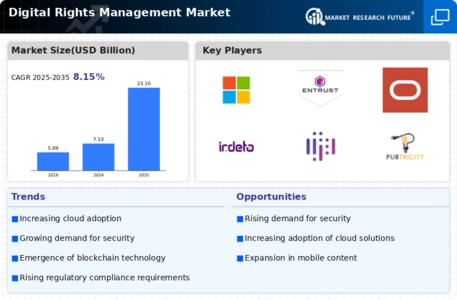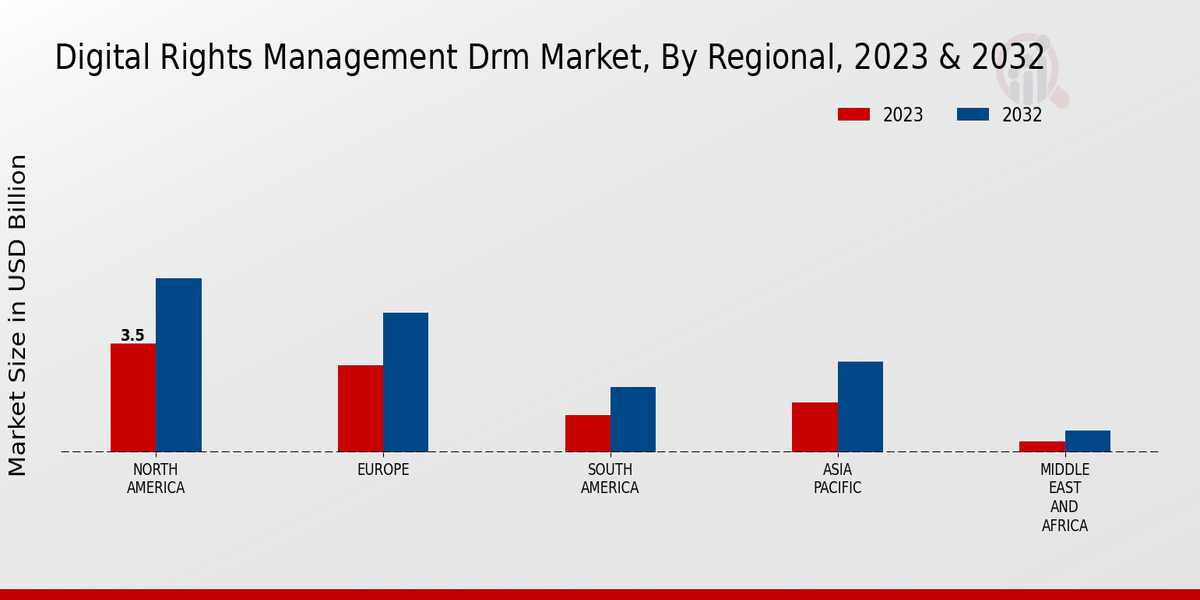Charts Only
Expansion of Streaming Services
The proliferation of streaming services significantly influences the Global Digital Rights Management Market Industry. As platforms like Netflix, Hulu, and Spotify expand their offerings, the necessity for effective DRM solutions becomes increasingly apparent. These services require stringent measures to protect their content from unauthorized access and distribution. The market is expected to grow substantially, with projections indicating a rise to 23.1 USD Billion by 2035. This growth is driven by the need for secure content delivery and the protection of licensing agreements. As more consumers shift towards subscription-based models, the demand for sophisticated DRM technologies is likely to increase, ensuring that content creators receive fair compensation.
Rising Demand for Content Protection
The Global Digital Rights Management Market Industry experiences a notable surge in demand for content protection as digital piracy continues to threaten intellectual property rights. With the increasing consumption of digital media, businesses are compelled to adopt robust DRM solutions to safeguard their assets. In 2024, the market is projected to reach 7.53 USD Billion, reflecting a growing recognition of the need for effective content protection strategies. Industries such as entertainment, publishing, and software are particularly affected, as they face significant revenue losses due to unauthorized distribution. Consequently, the implementation of DRM technologies is becoming essential for maintaining competitive advantage and ensuring revenue integrity.
Regulatory Compliance and Legal Frameworks
The Global Digital Rights Management Market Industry is significantly shaped by evolving regulatory compliance and legal frameworks surrounding digital content. Governments worldwide are implementing stricter laws to combat copyright infringement and protect intellectual property rights. This regulatory environment compels organizations to adopt DRM solutions that comply with legal standards. For instance, the European Union's Copyright Directive emphasizes the need for robust protection mechanisms for digital content. As a result, businesses are increasingly investing in DRM technologies to avoid legal repercussions and ensure compliance. This trend is expected to contribute to the market's growth, as organizations recognize the importance of adhering to legal requirements in their digital operations.
Technological Advancements in DRM Solutions
Technological advancements play a crucial role in shaping the Global Digital Rights Management Market Industry. Innovations in encryption, watermarking, and access control technologies enhance the effectiveness of DRM solutions. These advancements enable organizations to implement more sophisticated protection measures, thereby reducing the risk of unauthorized access and distribution. As the market evolves, the integration of artificial intelligence and machine learning into DRM systems is likely to provide enhanced security features and analytics capabilities. This technological evolution is expected to drive market growth, as businesses seek to leverage cutting-edge solutions to protect their digital assets and maintain a competitive edge in an increasingly digital landscape.






















